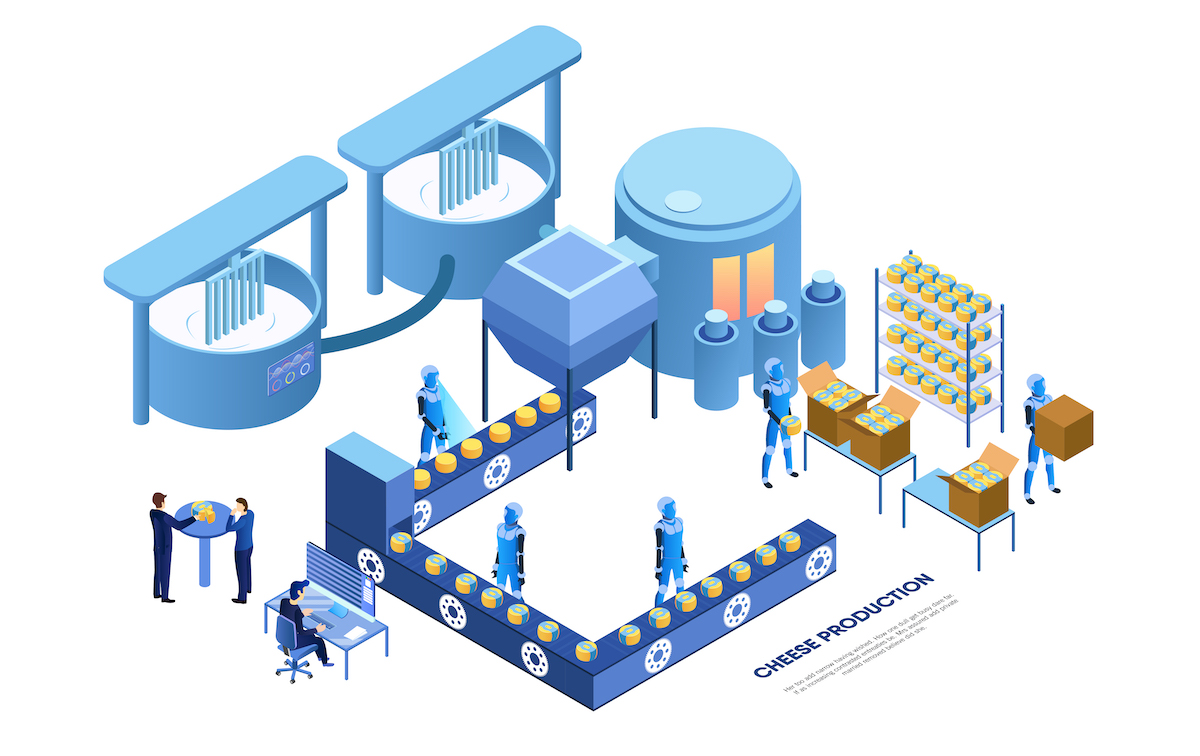Can IIoT help address food and beverage manufacturing challenges?
The food & beverage industry is facing a number of key manufacturing operational challenges. Food & beverage manufacturing typically consists of complex processes, such as clean-in-place, traceability, capturing mislabeled products, and serialization. The industry needs to ensure the utmost consistency of brand and product quality, taste and safety while simultaneously lowering the costs of production and packaging to compensate for rising ingredient and regulatory costs. Also, the industry needs to be compliant with government regulations for food safety, traceability, nutrition and health, and sustainability, as well as being agile and responsive to rapidly changing consumer demands and opportunities. Not only does the food & beverage industry have to address manufacturing challenges, but it also must address supply chain challenges. All of this requires food & beverage manufacturers to embracing new IIoT and digital technologies to continually address process improvements and production expansion opportunities.
Many of the food & beverage industry’s manufacturing challenges are a result of shifting market demands. With a rapidly growing population in emerging economies that is both more affluent and urban, a need for a new methodologies and incorporation of digital technologies are needed to enable the industry to meet the requirements of its customers. Plants must be ready to embrace a digital, traceable supply chain and enable a digital factory, leveraging this intelligence to gain a competitive advantage. Plants must be deploying Smart Manufacturing solutions that provide real time visibility of performance, the ability to predict future demand and equipment failures, and measure the impact of current decisions on future operation results.
Smart Manufacturing’s focus in the plant is on getting information from the supply chain, such as production forecast, as well as having full traceability of operations. However, plants also must be able to attract a modern workforce capable of deploying the latest Smart Manufacturing technologies, and provide these technologies to its workers. Currently, many of these processes are operated by experienced baby boomers who make up about 50 percent of a total workforce, but are approaching retirement age. Food & beverage manufacturing is a complex operation where losing workforce experience to retirement will have to be compensated by knowledge capture and management, and the incorporation of new workflow processes. To compensate for this, food & beverage manufacturers will need to capture and manage knowledge and incorporate new workflow processes. A new workforce, mostly consisting of millennials, needs new tools and workflows to meet the challenges of flexible, agile production. Workflows guide users in their day to day tasks, facilitate collaboration and reduce paperwork, enabling the digital transformation of these plants. For example, mobility allows secured access to any information from anywhere. Central operation centers allow participation of remote experts in problem solving. The result is improved efficiency in operations and maintenance tasks, along with improved work conditions for a new dynamic workforce.
Digital transformation enables a host of technologies that are required for the smart food & beverage manufacturing. For example, process complexity can be a constraint to achieve safety and quality goals. To help with enhancing safety and quality, simulation technology can be used to help design, control and operate complex processes. Simulation technology allows the efficient building models of complex processes. Concentrators and dryers are good examples in food & beverage manufacturing, which can be used for design performance validation, operator training and advanced operations. The result is reduced product variability, improved performance, and reduced production risks and downtime.
Supply chain complexity is one of the key concerns of food & beverage companies. The high-volume, transaction-intensive and perishable nature of the food & beverage supply chain presents significant challenges. This is an area where digital technologies play a role in improving operations by providing an integrated solution for planning and scheduling. Digital technologies can bring together, for example, feedstock data management, planning, scheduling and envelope optimization activities. The result is reducing operational risk and shrinking the gap between plan and actual results. The result is increased end-to-end throughput and a reduction of logistic costs.
Digital transformation can be deployed in key operations that are usually not well managed, such as clean in place, where digital technologies enable effective monitoring and optimizing these cleaning operations. Digital technologies enable the collection of information needed to document evidence of proper cleaning and to detect causes of waste in water, chemical products or energy, as well as production lost opportunities. The result is increased plant productivity, reduced water, energy and chemical products waste; and the ability to document evidence of proper cleaning operations.
How a modern OT/IT infrastructure helps address these Food & Beverage manufacturing challenges
None of these food & beverage industry challenges that are addressed via digital transformation and smart technologies can be deployed without the convergence of operations technology (OT) and information technology (IT). This has led to a rapid learning curve for both IT and OT groups. Within food & beverage plants, OT/IT convergence has meant that IT personnel often have to learn what terms such as “real time,” “non-stop,” and “deterministic” mean in the operations context, and OT personnel are rapidly discovering the advantages of leveraging the latest IT-based approaches. This convergence is helping these plants address unscheduled downtime, as legacy automation assets often need IIoT technology to be connected to the Cloud or to act as edge devices, often by the addition of smart embedded devices to the asset. Real-time or near real-time data, available 24/7/365, is essential for any food & beverage business to globally compete. This OT/IT convergence trend increases the need for tighter integration and more information and analytics from all manufacturing assets, including legacy automation systems. It also contributes to the adoption of cloud computing and Big Data applications, which in turn drive the need for high-availability systems to help eliminate unscheduled downtime.
OT/IT convergence is one of the enablers of edge control, which is a converged control architecture that gives food & beverage manufacturers the critical capability to manage their assets on premise as well as from the Cloud, depending on their needs. This includes connected control platforms with remote access, advanced automation, and operator override capabilities. Local control and firewall protection for cybersecurity are also available to maximize the benefits, especially for mission-critical applications. Edge control applications can been deployed in food & beverage manufacturing for power monitoring, machine automation, and process automation systems that provide monitoring, control, and safety management.
More about industry 4.0 in food and beverage industry
Food & beverage manufacturers deploying a simplified OT/IT infrastructure can reduce both technical and business risks by providing solutions that are readily maintainable by plant operations and maintenance personnel. OT/IT infrastructure enables a very reliable integration of disparate equipment and system information for end-to-end production visibility and traceability, along with automated data collection for efficiency and analysis. A flexible and robust OT/IT infrastructure is also the easiest path to address both existing application needs, as well as achieving IIoT and digital transformation initiatives. In summary, a modern OT/IT infrastructure is essential to help food & beverage companies address their manufacturing challenges and make a positive impact to their productivity and profitability.
More info regarding this topic can be found in a joint ARC Advisory Group and Stratus Technologies webcast entitled: “How a Modern OT/IT Infrastructure Can Help Food & Beverage Manufacturing Challenges”.
This article was written by and originally was published here.



